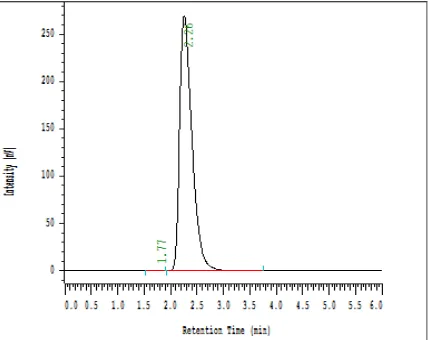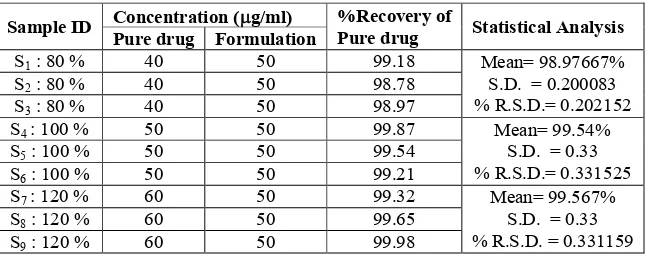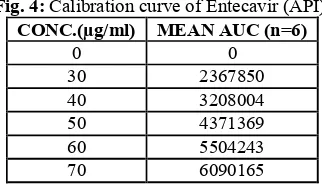B. Raj Kumar*
Dr. K.V.Subba Reddy Institute of Pharmacy, Kurnool, A.P, India
E-mail: rajpharma2631@yahoo.com
Address for correspondence
B. Raj Kumar et al. / JGTPS/5(3)-(2014) 1833 –1838
A NEW VALIDATED STABILITY-INDICATING RP-HPLC METHOD FOR THE
DETERMINATION OF ENTECAVIR
INTRODUCTION:
[4-5] BARACLUDE® is the tradename for entecavir, a guanosine nucleoside analogue with selective activity against HBV. The chemical name for entecavir is
2-amino-1,9-dihydro-9-[(1S,3R,4S)-4hydroxy-3- (hydroxymethyl)-2-methylenecyclopentyl]-6H-purin-6-one, monohydrate. Its molecular formula is C12H15N5O3•H2O, which corresponds to a molecular weight of 295.3. Entecavir has the following structural formula:
Fig 1:Showing the structure of Entecavir
Entecavir is a white to off-white powder. It is slightly soluble in water (2.4 mg/mL), and the pH of the saturated solution in water is 7.9 at 25° C ± 0.5° C. BARACLUDE film-coated tablets are available for oral administration in strengths of 0.5 mg and 1 mg of entecavir. BARACLUDE 0.5 mg and 1 mg film-coated tablets contain the following inactive ingredients: lactose monohydrate, microcrystalline cellulose, crospovidone, povidone, and magnesium stearate. The tablet coating contains titanium dioxide, hypromellose, polyethylene glycol 400, polysorbate 80 (0.5 mg tablet only), and iron oxide red (1 mg tablet only). BARACLUDE Oral Solution is available for oral administration as a ready-to-use solution containing 0.05 mg of entecavir per milliliter. BARACLUDE Oral Solution contains the following inactive ingredients: maltitol, sodium citrate, citric acid, methylparaben, propylparaben, and orange flavor.[1]-[3]
EXPERIMENTAL METHODS[6]-[17]
METHOD DEVELOPMENT
HPLC Instrumentation & Conditions:
The HPLC system employed was HITACHI L2130 with D Elite 2000 Software with Isocratic with UV-Visible Detector (L-2400),
Entecavir is an oral antiviral drug used in the treatment of hepatitis B infection. It is marketed under the trade name Baraclude (BMS). Entecavir is a guanine analogue that inhibits all three steps in the viral replication process, and the manufacturer claims that it is more efficacious than previous agents used to treat hepatitis B (lamivudine and adefovir). ). A novel, stability-indicating reversed-phase high performance liquid chromatography (RP-HPLC) method has been developed for the quantitative determination of Entecavir in active pharmaceutical ingredients and in its Pharmaceutical dosage form by using develosil C18, 5µm, 150 x 4.6 mm i.d. column with a mobile phase containing a mixture of Acetonitrile and Potassium dihydrogen phosphate buffer adjusted to pH3.4 with ortho phosphoric acid in the ratio of 40:60. The flow rate was 1.0 ml/min and effluent was monitored at 257 nm and a peak eluted at 2.26 min and column oven temperature was maintained ambient. Calibration curve was plotted with a range from 30-70 µg/ml. Stress degradation conditions were established for Entecavir by subjecting it to acid, base, oxidation and thermal stress. The stress samples were assayed against a qualified reference standard and the mass balance was close to 99.31%.The developed RP-HPLC method was validated according to the current International Conference on Harmonization (ICH) guidelines for specificity, LOD, LOQ, linearity, accuracy, precision, intermediate precision and robustness. The results of the study showed that the proposed RP-HPLC method is simple, rapid, precise and accurate, which is useful for the routine determination of Entecavir in bulk drug and in its pharmaceutical dosage form.
Keywords:Entecavir, RP-HPLC, ODS, ICH, LOD, LOQ
ABSTRACT
B. Raj Kumar
1*
Dr. K. V. Subrahmanyam
21Assistant Professor
Department of Pharmaceutical Analysis, Dr. K.V.Subba Reddy
Institute of Pharmacy, Kurnool, A.P,India
2Principal & Professor
Department of Pharmaceutical Analysis, Samskruthi College of Pharmacy, Ghatkeskar, Hyderabad
Journal of Global Trends in Pharmaceutical Sciences
Journal home page: www.jgtps.com
ISSN: 2230-7346
Standard & sample preparation for UV-spectrophotometer analysis:
25 mg of Entecavir standard was transferred into 25 ml volumetric flask, dissolved & make up to volume with mobile phase. Further dilution was done by transferring 0.1 ml of the above solution into a 10ml volumetric flask and make up to volume with mobile phase. The standard & sample stock solutions were prepared separately by dissolving standard & sample in a solvent in mobile phase diluting with the same solvent.(After optimization of all conditions) for UV analysis. It scanned in the UV spectrum in the range of 200 to 400nm. This has been performed to know the maxima of Entecavir, so that the same wave number can be utilized in HPLC UV detector for estimating the Entecavir. While scanning the Entecavir solution we observed the maxima at 257 nm. The UV spectrum has been recorded on ELICO SL-159 make UV – Vis spectrophotometer model UV-2450. The scanned UV spectrum is attached in the following page
Fig 2:Showing the UV Spectrum of Entecavir
MOBILE PHASE PREPARATION
The mobile phase used in this analysis consists of a mixture of Buffer (0.05 M potassium dihydrogen phosphate & pH adjusted to 3.4 with orthophosphoric acid) and Acetronitrile in a ratio of 60:40.
600 ml of this buffer solution was added and properly mixed with 400 ml of acetronitrile and a homogenous solution is achieved. This mobile phase was filled and sonicated for 15 minutes before using in the experiment
SAMPLE & STANDARD PREPARATION FOR THE ANALYSIS
10 mg of Entecavir standard was transferred into 10 ml volumetric flask, dissolved & make up to volume
Optimization of Chromatographic Conditions: The chromatographic conditions were optimized by different trails. (Using different column, different mobile phase, different flow rate, different detection wavelength & different diluents for sample preparation etc. The Optimum conditions obtained from experiments can be summarized as Develosil ODS HG-5 RP C18, 5m, 15cmx4.6mm I.D was used for analysis at column temperature 45°C. The mobile phase was pumped through the column at a flow rate of 1.0 mL/ min. The sample injection volume was 20 μL and the sample temperature was maintained at Ambient. The wavelength of UV-282 nm was set for Entecavir and Chromatographic Gradient programme runtime was 6 minutes.
Fig. 3:HPLC spectrum of Entecavir (50 ppm) in optimized conditions (RT 2.26 min.)
RESULTS AND DISCUSSIONS:
To develop a suitable and robust LC method for the determination of Entecavir in different mobile phases were employed to achieve the best separation and resolution. The method development was started with Symmetry C18; 250 mmx4.6 mm I.D; particle size 5 μm with the flow rate of 1.0ml/min. Mobile phase was Buffer and Acetronitrile in the ratio of 60:40%, Column temperature was Ambient and the wavelength was 210nm. The retention time of Entecavir is 2.6 minutes and the peak shape was broad. For better peak shape the mobile phase pH and Composition was changed, the trial-5 shown a sharp peak with good resolution on replacing the column with C18Develosil ODS HG-5 RP 150mm x 4.6mm 5µm particle size with Rt of 2.26 minutes
METHOD VALIDATION:
Sample ID Concentration (g/ml) %Recovery ofPure drug Statistical Analysis Pure drug Formulation
S1: 80 % 40 50 99.18 Mean= 98.97667% S.D. = 0.200083 % R.S.D.= 0.202152 S2: 80 % 40 50 98.78
S3: 80 % 40 50 98.97
S4 : 100 % 50 50 99.87 Mean= 99.54% S.D. = 0.33 % R.S.D.= 0.331525 S5: 100 % 50 50 99.54
S6: 100 % 50 50 99.21
S7 : 120 % 60 50 99.32 Mean= 99.567% S.D. = 0.33 % R.S.D. = 0.331159 S8: 120 % 60 50 99.65
S9: 120 % 60 50 99.98
Table 1: Showing the Results of Accuracy
Precision: Repeatability
The precision of each method was ascertained separately from the peak areas & retention times obtained
by actual determination of five replicates of a fixed amount of drug. Entecavir (API) the percent relative standard deviation was calculated for Entecavir is presented in the table 2.
HPLC Injection
Replicates of Entecavir Retention Time Area Replicate – 1 2.26 4371369 Replicate – 2 2.29 4327048 Replicate – 3 2.29 4372696 Replicate – 4 2.29 4283857 Replicate – 5 2.3 4340455 Average 0.015166 36636.23285 Standard Deviation 2.286 4339085
% RSD 0.663419 0.844330841
Table 1: Showing the Results of Repeatability
Intra-assay & inter-assay:
The intra & inter day variation of the method was carried out & the high values of mean assay & low
values of standard deviation & % RSD (% RSD < 2%) within a day & day to day variations for Entecavir revealed that the proposed method is precise
Conc. of Entecavir (API) (µg/ml)
Observed Conc. of Entecavir (µg/ml) by the proposed method Intra-Day Inter-Day
Mean (n=6) % RSD Mean (n=6) % RSD
10 10.08 0.96 10.03 0.97
20 20.04 0.40 30.03 0.42S
40 39.97 0.33 39.95 0.14
Table 4: Results of intra-assay & inter-assay
Linearity & Range:
The calibration curve showed good linearity in the range of 00 – 70 µg/ml, for Entecavir (API) with
Fig. 4:Calibration curve of Entecavir (API). CONC.(µg/ml) MEAN AUC (n=6)
0 0
30 2367850 40 3208004 50 4371369 60 5504243 70 6090165
Table 5: Results of Linearity & Range
LOD & LOQ:
The Minimum concentration level at which the analyte can be reliable detected (LOD) & quantified (LOQ) were found to be 0.05 & 0.15 µg/ml respectively.
ASSAY OF ENTECAVIR IN DOSAGE FORM:
Assay was performed as described in previous chapter. Results obtained are tabulated below:
Brand name of tablets
Labelled amount of
Drug (mg) Mean (SD) amount (mg) found by the proposed method (n=6) Mean ((n = 6)SD) Assay Entavir 0.5 0.49 (0.06) 98.00 (0.48)
Table 6: Assay of ENTECAVIR tablets
The assay of Entavir tablets containing Entecavir was found to be 98.00 %.
Method Robustness:
Influence of small changes in chromatographic conditions such as change in flow rate ( 0.1ml/min), Temperature (20C), Wavelength of detection (2nm) & acetonitrile content in mobile phase (2%) studied to determine the robustness of the method are also in favour of (Table-4, % RSD < 2%) the developed RP-HPLC method for the analysis of Entecavir( API).
Change in parameter % RSD Flow (1.1 ml/min) 0.07 Flow (0.9 ml/min) 0.02 Temperature (270C) 0.09 Temperature (230C) 0.13 Wavelength of Detection (270 nm) 0.04 Wavelength of detection (266 nm) 0.01
Table 7: Result of method robustness test
STABILITY RELATED IMPURITY STUDIES:
Following protocol was strictly adhered to for forced degradation of Entecavir Active Pharmaceutical Ingredient (API).
The API (Entecavir) was subjected to stress conditions in various ways to observe the rate and extent of degradation that is likely to occur in the course of storage and/or after administration to body.
This is one type of accelerated stability studies that helps us determining the fate of the drug that is likely
1. ACID HYDROLYSIS:
An accurately weighed 25 mg. of pure drug was transferred to a clean & dry 25 ml volumetric flask. To which 0.1 N Hydrochloric acid was added & make up to the mark & kept for 24 hrs. from that 4 ml was taken in to a 10 ml volumetric flask & make up to the mark with mobile phase, then injected into the HPLC system against a blank of HCL ( after all optimized conditions )
1
.
7
7
2
.
9
6
3
.
1
3
0 1 2 3 4 5 6 7 8 9 10
Retention Time (min) 0
5 10 15 20 25 30
I
n
t
e
n
s
i
t
y
(
m
V
)
BASIC HYDROLYSIS
An accurately weighed 10 mg. of pure drug was transferred to a clean & dry 10 ml volumetric flask. To which 0.1 N Sodium hydroxide was added & make up to the mark & kept for 24 hrs. from that 4s ml was taken in to a 10 ml volumetric flask & make up to the mark with mobile phase, then injected into the HPLC system against a blank of NaOH ( after all optimized conditions )
1
.
7
9
2
.
9
7
3
.
1
3
0 1 2 3 4 5 6 7 8 9 10 Retention Time (min)
0 5 10 15 20 25
I
n
t
e
n
s
i
t
y
(
m
V
)
Fig 6: Chromatogram showing degradation related impurity in 0.1 N NaOH 4372696
Sl. No Rt Peak Area Peak Concerntartion 1 1.79 87453 1.76 2 2.96 1934167 47.91 3 3.13 2308574 49.51
Table 9: Results of Basic hydrolysis
4. Photolytic Degradation:
Approximately 10 mg. of pure drug was taken in a clean & dry Petridis. It was kept in a UV cabinet at 254 nm wavelength for 24 hours without interruption. Accurately weighed 1 mg. of the UV exposed drug was transferred to a clean & dry 10 ml. volumetric flask. First the UV exposed drug was dissolved in methanol & make up to the mark. Then injected into the HPLC system against a blank of mobile phase (after all optimized conditions)
1
.
7
7
2
.
9
6
0 1 2 3 4 5 6 7 8 9 10 Retention Time (min)
0 10 20 30 40 50
I
n
t
e
n
s
i
t
y
(
m
V
)
Fig. 7: Chromatogram showing photolytic degradation.
NO RT AREAPEAK CONCENTRATIONPEAK 1 2.96 4372696 99.915
Oxidation with (3%) H2O2:
Accurately weighed 25 mg. of pure drug was taken in a clean & dry 25 ml. volumetric flask. 3 ml. of 3% H2O2 and a little methanol was added to it to make it soluble & then kept as such in dark for 24 hours. Final volume was made up to 100 ml. using water to prepare 100 ppm solution. The above sample was injected into the HPLC system.
1
.
7
7
2
.
9
6
0 1 2 3 4 5 6 7 8 9 10
Retention Time (min) 0
10 20 30 40 50
I
n
t
e
n
s
i
t
y
(
m
V
)
Results of degradation studies:
The results of the stress studies indicated the specificity of the method that has been developed. Entecavir was degraded in acidic, basic & 3 % hydrogen peroxide & stable at thermal & light stress conditions. The result of forced degradation studies are given in the following table.
Table 3:Results of force degradation studies of Entecavir API.
Stress
condition Time
Assay of active substance
Assay of degraded products
Mass Balance
(%) Acid
Hydrolysis (0.1 M HCl)
24Hrs. 43.75 54.61 98.36
Basic Hydrolysis (0.I M NaOH)
24Hrs. 43.32 55.02 98.32
Thermal Degradation
(50 0C) 24Hrs. 97.39 --- 97.39 UV (254nm) 24Hrs. 95.19 04.34 99.53 3 % Hydrogen
peroxide 24Hrs. 95.75 04.28 100.03
CONCLUSION:
The proposed HPLC method is rapid, sensitive, precise and accurate for the determination of Entecavir and can be reliably adopted for routine quality control analysis of Entecavir in Bulk and its pharmaceutical formulations
ACKNOWLEDGEMENT:
The authors are thankful to Aravinda Patnaik, Research analyst, COMPRIME Labs, Hyderabad for his help for providing all facilities to complete the work and Dr. Reddy Labs for providing the drugs.
REFERENCES:
1. http://www.nlm.nih.gov/medlineplus/druginfo/me ds/a605028.html
2. http://en.wikipedia.org/wiki/Entecavir 3. http://www.rxlist.com/baraclude-drug.htm 4. http://www.accessdata.fda.gov/drugsatfda_docs/n
da/2011/202022Orig1s000TOC.cfm 5. http://www.baraclude.com/index.aspx
6. Scholars research library der pharma chemica, 2011, 3 (4): 63-68 issn 0975-413x oden (usa): pchhax
7. International journal of chemtech research coden( usa): ijcrgg issn : 0974-4290 vol. 3, no.2, pp 766-771, april-june 2011
8. International journal of advances in pharmaceutical sciences, vol.1 no.2 (2010) 9. http://dx.doi.org/10.3329/dujps.v9i2.7898 dhaka
univ. J. Pharm. Sci. 9(2): 131-138, 2010 (december) bangladesh journals online
10. Instrumental method of analysis by rabi sankar, p-18-6, p-18-3
11. Practical hplc method development by lloyd r. Snyder et al; 2ndedition, p-503
12. Guidance for industry, analytical procedure and method validation, u.s. Department of health and human services fda, august 2000 (www.fda.gov/guidance/index.htm)
13. Y. F. Cheng, t.h. Walter, z. Lu, p. Iraneta, c. Gendreau, u. D. Neue, j. M. Grassi, j. L. Carmody, j. E. O’ gara, and r. P. Fisk, lcgc 18(10), 1162 (2000)
14. The united state pharmacopeia 25/national formulary 20, ch. 1225, pg. 2256-2259 (the united state pharmacopial convention, inc., rockville, maryland, 2002)
15. ICH Guidelines on Validation of Analytical procedure: Text and Methodology Q 2 (R1), (2011).
16. ICH Q2B: Validation of analytical procedures; methodology, May (1997) 8.
17. International Conference on Harmonization of technical requirements for the registration of pharmaceutical for human use (ICH) Q2B (1996). Validation of analytical procedures, methodology.
All © 20104 are reserved by Journal of Global Trends in Pharmaceutical Sciences How to cite this article:



